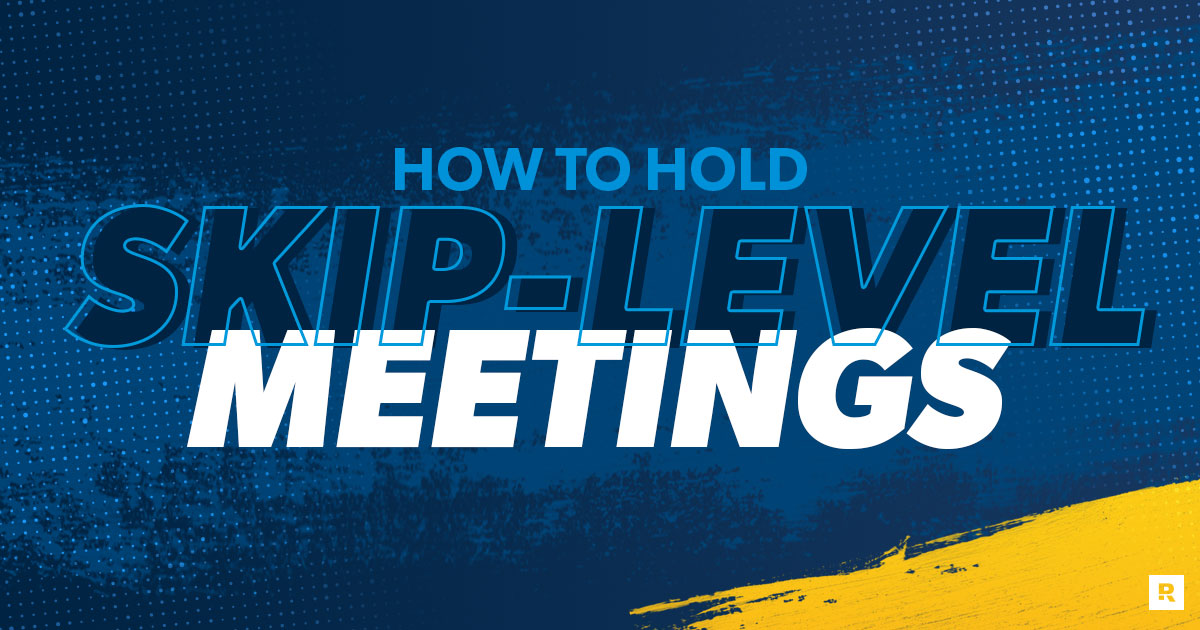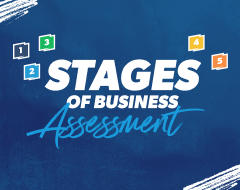
Smart business leaders pull instead of push. They know when to step back in their business, get a fresh perspective, and then use what they learn to help move their team and their mission forward. But how do they get that fresh perspective? Well, sometimes it starts by doing things differently. That’s where skip-level meetings come into play.
What Is a Skip-Level Meeting
Skip-level meetings are when a company’s top leader, like the business owner or CEO, bypasses the normal reporting structure and meets directly with team members who report to other directors or managers in the company. Basically, you’re skipping a reporting level. (Get it now?)
The leader’s goal is to learn from team members they wouldn’t normally hear from and get a better idea of where the company is winning and where it might have blind spots. But how do you have productive conversations with team members who aren’t your direct reports—especially without giving off the vibe that they’re in trouble? You make skip-level meetings part of your overall communication strategy—and you run them like a rock star.
Wait, are you sure my team members won’t feel like they’re being called to the principal’s office?
They shouldn’t. Once everyone is clear on what a skip-level meeting is, those school principal vibes probably won’t even be a thing. That said, if you don’t set up a skip-level meeting with thought and care, things could backfire. So it’s good to be absolutely clear on these two points:
1) A skip-level meeting is only weird if you make it weird or if your timing is weird.
2) A skip-level meeting can be an amazing tool if you make a solid plan and communicate like the rock star we already know you are.
Now, let’s push all the elephants out of the room and do some amazing team and business building!
A Skip-Level Meeting Is:
- A preplanned one-on-one or group meeting between a key leader and team members who normally report to the key leader’s directors or managers
- A tool to strengthen communication between leaders and team members who don’t typically interact with each other
- A coordinated effort to build unity and show that you value your team
- A way to bridge knowledge gaps and share different perspectives
- A source of engagement and productivity
A Skip-Level Meeting Isn’t:
- A last-minute, knee-jerk reaction to a toxic work situation
- A time to gossip, give bad news, or discipline the team member
- A power play over a manager or director
- A decision-making, problem-solving or big-idea moment
- A chance for the top dog to bark out orders and remind the team who’s the alpha
If you need to meet with someone else’s direct reports to correct a situation, that’s a much different conversation for a much different setting. Wondering how you can prep for having healthy confrontation in your business? Check out this article.
Preparing for Your Skip-Level Meeting From Start to Finish
Now that your head is in the right space, it’s time to plan your meetings and loop in your entire team. Remember what Zig Ziglar said about doing intentional, up-front work: “There are no traffic jams on the extra mile.” Putting in the effort now will set you and your team up to get the most out of your time together. Here’s how:
- Start by talking to your managers and directors so they know who you’ll meet with, when you’ll meet, and what you’ll talk about. To be clear is to be kind, so fill them in on the questions you plan to ask the team members and how you’ll use their input.
- Let your team leads give the people who normally report to them the heads-up. This will help ease any concerns and signal that you’re all in this together.
- Schedule follow-ups with your directors and managers (before any skip-level meetings happen) to share what you learn. Great leadership means overcommunicating and keeping the trust and respect flowing with your team.
- Make sure you have the time to meet with all (yes, every single one) of your directors’ or managers’ team members. This may mean you focus on just one or two departments at a time, but you should still communicate the full plan and stick to it the best you can.
- Set a realistic skip-level meeting time. An example would be 40 minutes per one-on-one, held every January for some groups and September for the rest.
- Add 10 minutes to the end of each meeting to answer team member questions and another 10 minutes afterward to write down what you learned. Don’t forget to note any extra actions you’ll need to take.
- Block off time on your calendar when all the meetings are done to look at trends and ideas from those meetings.
- Follow up with your leaders. This is where you’ll work through next steps and close any decision-making loops.
- Get your whole team together in a meeting to tell them what you learned and what company changes might be in the works as a result.
Ready to Level Up Your Business?
Find out your Stage of Business with our free assessment and get additional resources to help you level up by focusing on the right things at the right time.
7 Tips for How to Run Skip-Level Meetings
Okay, the planning is done, the meetings are set, and you’re ready to sit knee to knee with team members you don’t hear from every day. Here are seven pro tips to send you on your way to being a two-thumbs-up, five-gold-stars, and double-high-five meeting machine.
1. Lead with clear purpose.
Remind every team member why the company exists and how they’re part of fulfilling the mission.
2. Set the tone.
You’re there to learn, not to solve all the world’s problems or make earth-moving decisions. Communicate with respect, ask great questions, and then listen.
3. Be open to what your team member is sharing.
Don’t defend, argue or overexplain anything. This is a safe space. If you can’t treat it like one, you shouldn’t be meeting. You should want to hear their concerns—even if you don’t see things the way they do. Here are some solid responses to keep the conversation going: “Thank you for being honest. Tell me more about that.” “Can you clarify that?” “Today my focus is on learning. Let’s talk more about that in a separate meeting, and I’ll follow up once I have the bigger picture.”
4. Encourage your team members.
A simple, sincere thank-you goes a long way. Bonus points for giving feedback on something specific you know they’re kicking butt on. Double bonus points if you know their DISC personality profile and communicate in the way that means the most to them.
5. Share next steps.
Let the team members know you’ll be blocking off time for yourself to put all the learnings together. Then, end with a specific note of appreciation for what they shared and encourage them to talk with their direct leader as they need to.
6. Stick to the follow-ups you promised.
If working through concerns is more complicated than you thought, just say so and let them know you’re working on it. (Great follow-ups build unity and make room for healthy and honest conversations.)
7. Consider creating new key performance indicators (KPIs).
KPIs help your team members see where the business is hitting or missing the mark.
Sample Skip-Level Meeting Questions
When it comes to skip-level meetings, remember: You don’t want an elephant to even poke its trunk in the room. So, just lead with a smile and talk to team members . . . as in have honest, natural conversations with them. That should look like going from light, general topics to deeper, more business-focused ones. Here are some examples of questions to help you guide the conversation.
General:
- Where did you grow up?
- What’s your family like?
- What do you like to do outside of work?
- What do you like to read, watch or listen to the most?
- What do you like most about your role in our company?
Job:
- What brought you to our business?
- How have you grown through your work?
- Is anything holding you back from growing?
- What’s the best thing about working with your team and leader? What’s the hardest?
- What’s something you would like to start, stop, change or continue in your work?
- How supported do you feel in your work? What resources or changes would help improve that?
Company:
- How do you connect with our company’s mission and vision?
- How well do you see us nailing our mission (or not nailing it) companywide and in your team?
- How do you feel about where our company is going?
- Are there any situations you think our leaders have or haven’t handled well?
- What questions or concerns do you have about a trend you’ve seen in our leadership?
Close:
- What’s something I might not be seeing that you think is important to point out?
- What final thoughts do you have on our business and how the leadership team can help you?
What’s Next
Now that you know how to run skip-level meetings like a pro, it’s time for you to step back and get a fresh perspective so your business and leadership can grow. In EntreLeadership, #1 national bestselling author Dave Ramsey guides you to everything you ever wanted to know about how to build strong teams and do work that matters.
If you’re looking for even more practical business and leadership tools, tune in to The EntreLeadership Podcast (and subscribe while you’re at it) to hear from today’s top business and personal growth experts.


